CTV Gold Rush: Capturing Audiences & Conquering Ad Fatigue
PUBLISH DATE: 11 December 2023
With viewers ditching traditional cable in favor of streaming services, advertisers are flocking to CTV to capture a captive and engaged audience. According to Insider Intelligence, US CTV ad spending is expected to reach $16.36 billion in 2023, accounting for 21.1% of all TV ad spending.
And this isn’t just a fleeting trend. CTV has officially surpassed traditional “linear” TV, leaving it in the dust. In fact, the number of CTV households is set to skyrocket, exceeding 115 million by 2024, more than double the number of linear TV homes.
What’s driving this shift? For advertisers, the answer is simple: CTV is a gold mine. Ad spending on linear TV is steadily declining, while CTV continues to soar, projected to increase by 21.2% year-on-year. And the numbers don’t lie – viewers are more likely to act on CTV ads, with a 23% higher purchase intent compared to linear ads.
However, with increased competition comes a new challenge: ad fatigue. Seeing the same ad repeatedly can lead to viewer apathy and a decline in engagement. To combat this, advertisers need to create dynamic and engaging CTV ad creatives that resonate with viewers
What is Consumer Fatigue?

Even in the captivating world of CTV, viewers can develop ad fatigue. This occurs when they’re repeatedly exposed to the same ad, leading to decreased attention and engagement.
Ad fatigue can seriously hinder the effectiveness of your CTV campaigns. It can lead to:
- Decreased brand recall: If viewers are constantly bombarded with the same ad, they’re less likely to remember your brand or message.
- Lower engagement: Viewer apathy towards repetitive ads translates to decreased interaction with your call to action.
- Negative brand perception: Constant exposure to the same ad can actually create a negative association with your brand in viewers’ minds.
To avoid these pitfalls, it’s crucial to diversify your ad creative and ensure viewers see fresh content regularly. Explore different formats, and messaging approaches, and even target specific audiences with tailored ad variations. By keeping your CTV advertising engaging, you can maintain viewer interest and maximize campaign impact.
Why does it matter?
With the continuous expansion of ad-supported streaming services in the connected TV, the available advertising inventory is on the rise. However, gaining clear insight into the CTV ad supply chain remains a challenge, complicating efforts to implement effective frequency capping.
- According to insider intelligence projections, by 2024, the number of viewers for free ad-supported streaming TV (FAST) is expected to reach 104.4 million, with ad-supported video-on-demand (AVOD) viewers reaching 180.2 million.
- Aluma Insights reports that 40% of US adults have increased their time spent on FASTs in the past year.
- The simultaneous growth of viewership and ad loads on both FAST and AVOD services has the potential to exacerbate ad fatigue.

1. Creative Variations
A) Interactive Media: Play around with CTV Ads is an effective way to capture user attention & drive engagement with interactive video elements like attaching QR codes, in video texts.
B) Edit the Order of Footage: Re-sequence your existing footage to create a new narrative flow, highlighting different aspects of your product or service. This simple switch can offer a fresh perspective and enhance audience engagement.
C) Refocus Your Scenes: Shift the spotlight to specific scenes within your existing material. This allows you to explore alternative storytelling angles and emphasize different benefits for the viewers.
D) Tweak Your Call to Action: Encourage viewers to take action & utilize generative AI to get actionable CTA that resonates most effectively with your target audience.
E) Refresh Your Voiceover: Give your ad a new voice by changing the voiceover artist or adjusting the script’s tone and language. This can significantly impact the overall feel and message of the ad, potentially attracting new audiences.
2. Target Your Ads Precisely with frequency capping
By setting a frequency cap on your CTV ads, you can ensure that they are not shown to the same viewer too often. This will help prevent ad fatigue and ensure that your ads remain engaging and effective.
Contextual relevance is key to engaging viewers and avoiding ad fatigue. This means tailoring your ads to the specific context in which it is being shown. This includes factors such as the:
- Channel: What type of content is typically shown on this channel?
- Program: What is the program about? What are the viewers likely to be interested in?
3. Keep it Fresh with Regular Rotation
For advertisers aiming for an “evergreen presence,” simply creating several variations and running them on repeat won’t suffice. You need to strike a delicate balance between delivering consistent, memorable messaging while constantly innovating to stay fresh and prevent viewer fatigue.
This might involve subtle tweaks to visuals, messaging, or even the overall tone of your ads to keep them engaging even throughout a year-long campaign.
Highlight the power of seasonality to create timely and relevant messaging that resonates with viewers. Aligning your ads with key holidays, events, or cultural moments allows you to capitalize on existing trends and conversations.
4. Use Diverse formats with different ad lengths
Not all viewers have the same attention span, so it’s important to test different ad lengths to see which ones perform best. This can help you find the sweet spot for your ads, ensuring that they are not too long or too short to be effective.
Ads can grab attention and tell a compelling story, while interactive ads offer a more engaging experience. Branded content allows you to subtly weave your brand message into existing content, creating a less intrusive and more natural experience.
Also Read: Unveiling the Real Potential of CTV for Marketers: Moving Beyond the Hype
CTV: The Future of Television and Avoiding Ad Fatigue
In conclusion, as Connected TV (CTV) continues to dominate the advertising industry, steering clear of ad fatigue emerges as a pivotal strategy for advertisers seeking optimal results.
By implementing dynamic and diverse ad creative strategies, such as interactive elements, strategic sequencing, and refreshed voiceovers, advertisers can combat viewer apathy and maintain high engagement levels. Precision targeting with frequency capping, adapting to contextual relevance, and utilizing diverse ad formats further enhance advertisers to get better results & high user interaction.
Unveiling the Real Potential of CTV for Marketers: Moving Beyond the Hype
PUBLISH DATE: 20 November 2023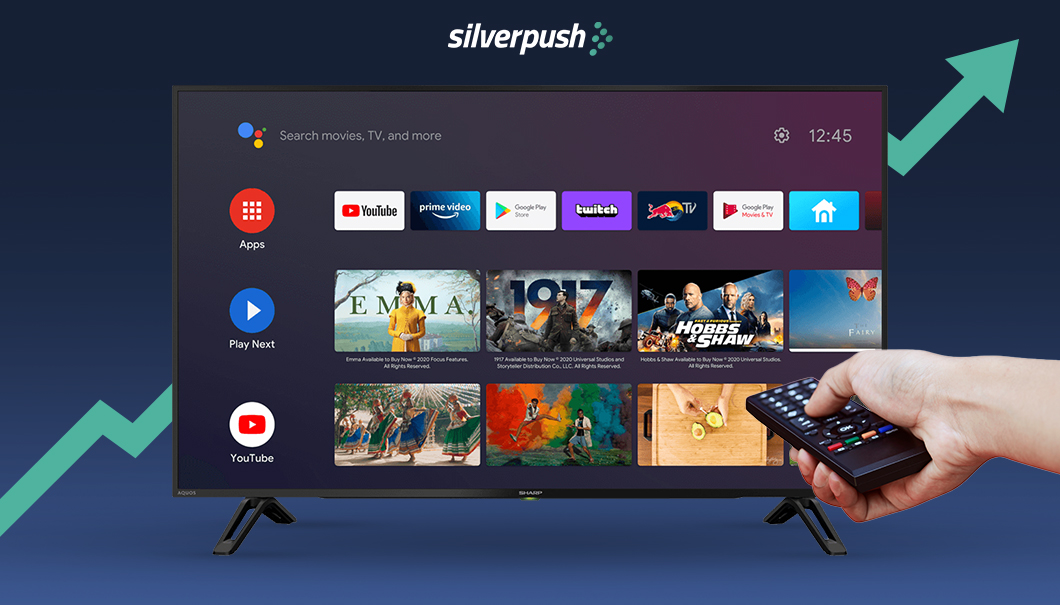
As consumers increasingly shift from traditional linear television to streaming services, marketers are recognizing the significant potential of addressable advertising in Connected TV (CTV). This shift allows for the delivery of tailored ads to different streaming viewers based on their audience persona, leading to more effective results in specific segments and facilitating advanced attribution.
Despite the growing enthusiasm for CTV advertising, it remains a relatively new channel for marketers. Understanding how inventory is bought, sold, and tracked on this platform is crucial. The deals in the CTV space that are most favorable to buyers need to be identified. Additionally, exploring the current state of CTV CPMs (cost per thousand impressions) is essential for marketers to make informed decisions.
To navigate the landscape of CTV ad inventory effectively, it’s crucial to delve into the factors influencing pricing in the channel. By gaining insights into attribution goals and challenges associated with CTV, marketers can strategically position their brands to capitalize on the emerging opportunities in this format. In the coming year, attention should be focused on key aspects of the CTV landscape to maximize the benefits for marketers.
Predicted growth of Connected TV Ad Spend in 2024
As we approach 2024, “Connected TV ad spend” has become the buzzword in the advertising realm, and for good reason. Anticipated trends suggest a significant surge in Connected TV ad spend, reshaping the landscape for advertisers and businesses.
Consider the following insights:
Prediction 1: According to a recent forecast by eMarketer, the projection for CTV ad spend in 2024 is an impressive $14.12 billion, marking a substantial increase from the $9.36 billion recorded in 2021.
Prediction 2: The same report indicates that the share of CTV ad spend in total TV ad spend is expected to climb to 44.6% by 2024. This signifies a notable shift in advertising strategies, with businesses increasingly favoring Connected TV advertising over traditional TV advertising.
The driving force behind this surge lies in evolving consumer behavior. The prevalence of over-the-top (OTT) media services such as Netflix and Hulu has led more consumers to transition from traditional TV to Connected TV. This shift creates a plethora of opportunities for advertisers to connect with a broader and more engaged audience, contributing to the predicted uptick in connected TV ad spend in 2024.
However, it’s crucial to emphasize that, with this newfound power, advertisers must wield it responsibly. While the rise in CTV ad spend is exciting, the focus should not merely be on spending but on spending wisely, adapting strategies to align with the evolving landscape.
How Advertisers can Leverage the CTV Surge?
Preparing for the surge in Connected TV (CTV) ad spend requires strategic planning. Here’s a guide to help advertisers capitalize on this opportunity:
Know Your Audience:
Start by understanding your target audience. Identify their interests, preferences, and viewing habits. This knowledge will serve as the foundation for your ad strategy, ensuring that your advertisements effectively resonate with your intended viewers.
Personalize Your Ads:
Harness the potential of CTV by creating personalized ads that cater to individual users. Tailor your content to speak directly to your audience, emphasizing the importance of relevance in your advertising efforts.
Leverage Data:
Utilize data from past campaigns to inform your future strategies. Analyze what worked well and what didn’t. By learning from both successes and mistakes, you can refine your approach and optimize your advertising efforts.
Test and Learn:
Given that CTV advertising is still in its early stages, there’s ample room for experimentation. Be bold in trying out different approaches to see what resonates best with your audience. Embrace a test-and-learn mentality to refine your strategies over time.
Stay Nimble:
The landscape of CTV advertising is evolving rapidly. Stay attuned to industry trends and be ready to adapt your strategies accordingly. Being nimble and responsive to changes will position your advertising efforts for continued success.
Also read: How Silverpush Ensures Brand Safety in CTV Advertising?
In conclusion, the anticipated increase in CTV ad spend presents a unique opportunity for advertisers. To make the most of this golden opportunity, it’s essential to stay informed, remain flexible, and always prioritize understanding and connecting with your audience. Are you ready to seize the moment? Contact us to get started with CTV advertising.
Half of All Consumers Prefer Brands that use Enhanced CTV Ad Formats
PUBLISH DATE: 26 October 2023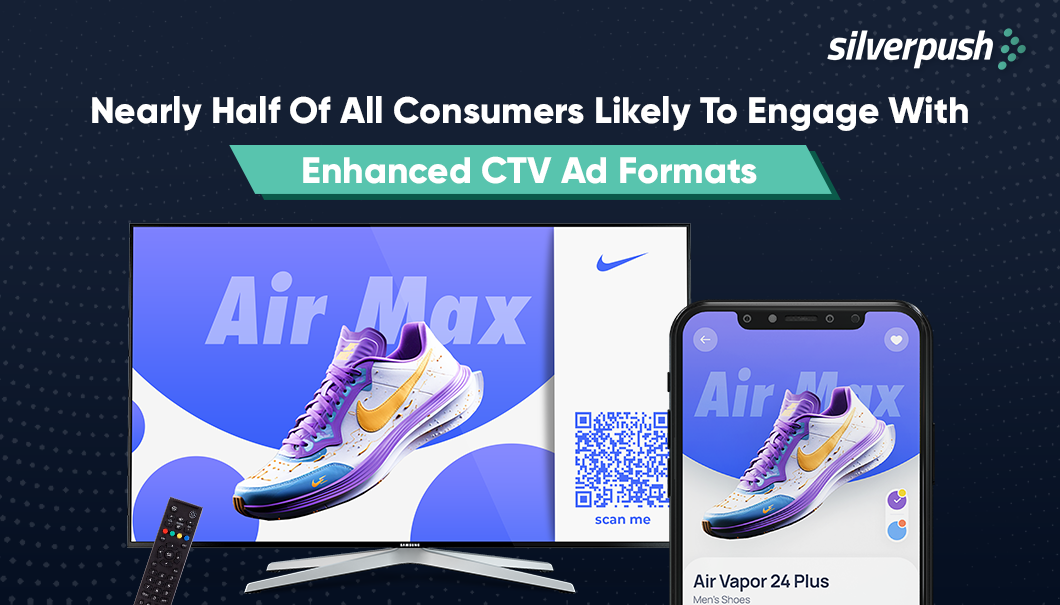
What do you think your audience does during commercial breaks? Maybe grab their phone, get some snacks, or check on their kids. What they are not doing is definitely paying attention to the TV. But once in a while, there’s a commercial that grabs their interest. As an advertiser, you know when a brand gets it right with its content and targeting.
Keeping the audience engaged is a challenge and it’s even hard to get them to take action. With regular TV, commercials just play, end, and hope they leave an impression. However, interactive content on CTV has a significant edge over traditional ads. But take note that just because viewers can interact, doesn’t mean they will. Brands must create engaging, personalized ads and provide viewers with a good reason to act.
Understanding the value of engaging content
Most CTV ads can’t be skipped, yet that doesn’t guarantee that people are truly paying attention to them. On average, you only have about eight seconds to grab a viewer’s focus.
CTV users may not be big fans of advertising, but they accept it. Research indicates that 64% of viewers prefer watching commercials over paying more for a subscription. However, with the incorporation of interactive features, advertisers can move beyond mere acceptance and foster engagement.
While interactivity in advertising is not unique to CTV, the results it generates are outstanding. Interactive CTV ads achieve engagement rates of over 5%, which is more than five times the engagement seen on PC or mobile platforms.
Personalization is a Stepping Stone to Good ROI
Half of successful engagement hinges on finding the right audience. For marketers and media buyers, this increasingly means highly precise targeting and tailored messaging. According to research from McKinsey & Company, a whopping 80% of consumers crave personalization from brands.
There is no question that untargeted ads might initially bring in leads, but we all know they often result in burning through ad budgets when retargeted to low-quality prospects or chasing segments that never convert. In order to maintain a good return on investment (ROI), personalization is the key.
Why Interactive CTV?
CTV has increasingly become a full-funnel solution for advertisers to build a brand amongst their target audience and maximize reach. Adding an additional layer of interactivity to CTV ad formats will bring you much closer to achieving your business goals.
| What you achieve with CTV | What you achieve with CTV Interactive |
| Improve the effectiveness of your advertising efforts with new media | Improve marketing ROI |
| Create and expand brand awareness | Increase social interaction and social sharing |
| Improve brand recall by making a lasting impression on participants | |
| Differentiate from your competitors and stand out | |
| Gain access to advanced analytics to refine your advertising approach | |
| Boost conversions and sales | |
| Generate higher-quality leads | |
| Gain new customers | |
| Increase customer loyalty |
How to Create Compelling Interactive CTV Ads?
Engagement is just the beginning, the real battle starts as you want users to take action on these ads too. Traditional TV often stumbles here, as viewers need to disengage from the TV to make a call or visit a website. This is where CTV excels as it reduces friction points.
By seamlessly integrating interactions, advertisers can minimize drop-offs and guide more consumers through the conversion funnel. Here are two ways to enhance user engagement:
1. Meeting Audience Needs and Desires in their High-Intent moments
The average American has around five hours of daily free time, with over 100 minutes devoted to connected TV like Roku, Apple TV, or Amazon Fire TV. Everyday activities like shopping and cooking are necessary but eat into leisure time.
Interactive CTV ads make it easy for brands to encourage viewers to take action with minimal effort. For instance, Roku has achieved success with partnerships that integrate daily activities into online promotions:
- Teaming up with Walmart, Roku enables viewers to make purchases directly on their CTV in just two clicks.
- Their partnership with DoorDash directs users to the delivery service and allows restaurants to offer targeted promotions.
Such broad applications illustrate how brands can streamline the customer journey. Targeting specific audiences to deliver contextually relevant ads opens up numerous possibilities. For instance, an online gaming company can:
- Segment prospective and retargeting audiences based on demographics and existing users.
- Create a creative with QR codes for app downloads for new users or promo displays for returning customers.
- Place media buys programmatically on sports-related content.
- Use appropriate customer intelligence platform to analyze customer journey and optimize campaign in real-time.
2. Deliver not just ads, but an Experience to your viewers
While most CTV viewers might not think twice about ordering dinner from an interactive commercial, asking them to buy a car or book a vacation in the same way may not be as successful. A transactional approach can fall short, whereas offering an experiential interaction can pique user interest. For example, a global car brand interactive CTV ad did this masterfully, allowing viewers to explore the car and connect with a dealership.
Numerous industries can leverage the flexibility of interactive CTV, but entertainment and media have a unique advantage. Imagine setting up a campaign to promote a pop star’s new album and tour. Existing music video footage serves as an excellent creative base for various promotions:
- Scan the QR code to stream the album.
- Collect viewer phone numbers to send ticket information for nearby tour dates.
- Offer interactive behind-the-scenes footage to maximize engagement.
As CTV continues to evolve, advertisers will have access to more detailed analytics, and streaming platforms will enhance interactive features. Brands that combine engaging and innovative content with customer intelligence are positioned to excel in CTV advertising. Contact us today to see how Silverpush’s innovative AI solution – Crafters with its enhanced ad formats on CTV can help you achieve greater audience engagement.
The Dawn of a New Advertising Era: 5 CTV Advertising Trends for 2024
PUBLISH DATE: 16 October 2023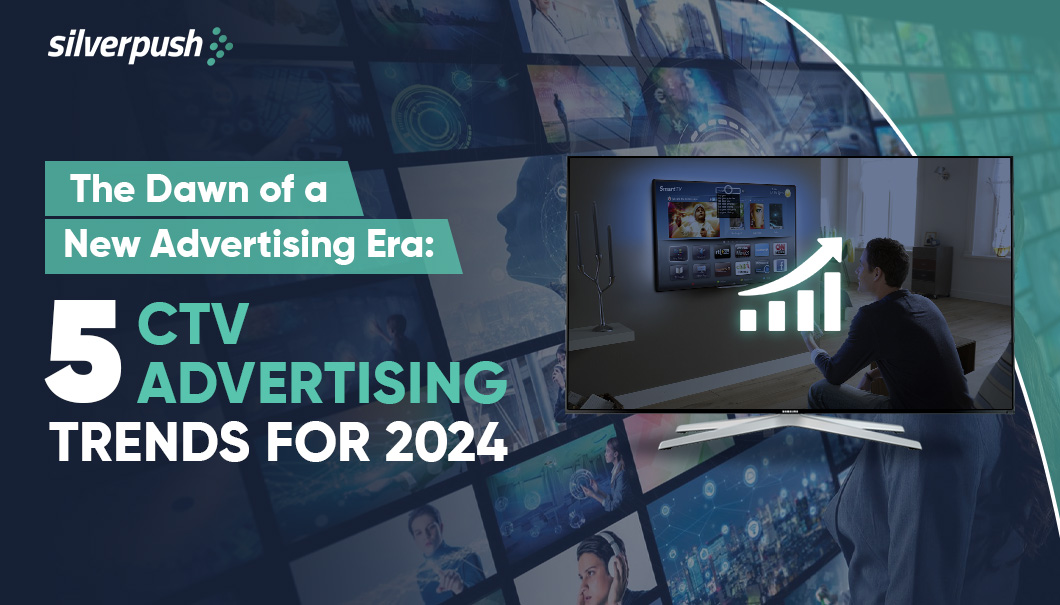
The advertising industry, particularly Connected TV (CTV), has witnessed remarkable growth in 2023, poised to exceed the global revenue milestone of $25 billion. This surge can be attributed to several key factors:
Firstly, the surging popularity of Connected TV has been remarkable. Recent studies indicate a 20% increase in CTV consumption among U.S. households, totaling a staggering 11.5 billion hours from May 2022 to May 2023.
Secondly, CTV advertising offers unparalleled targeting capabilities. Brands can now tailor their advertisements to particular audiences, leveraging demographic, interest, and behavior-based targeting. This precision sets CTV advertising apart from traditional TV advertising, which often reaches a more generalized audience.
Lastly, CTV advertising proves to be cost-effective. Advertisers benefit from the ability to precisely target their desired audience and measure the results with greater accuracy.
As we approach 2024, the future of CTV advertising trends holds great promise. To echo the sentiment, Ernest Hemingway once said, “New Year – A new beginning. And things will be better than ever before, you’ll see.”
Trends that will rule the Connected TV landscape in 2024
1. Uninterrupted Rise: CTV Viewership Continues to Surge
According to a renowned market research company, CTV households will be more than double the households with linear TV. 87 percent of American households with televisions had a device that can connect to the internet. This includes smart TVs, streaming devices like Roku and Amazon Fire TV, video game systems, and Blu-ray players3. Furthermore, the number of CTV users among generations is constantly increasing.
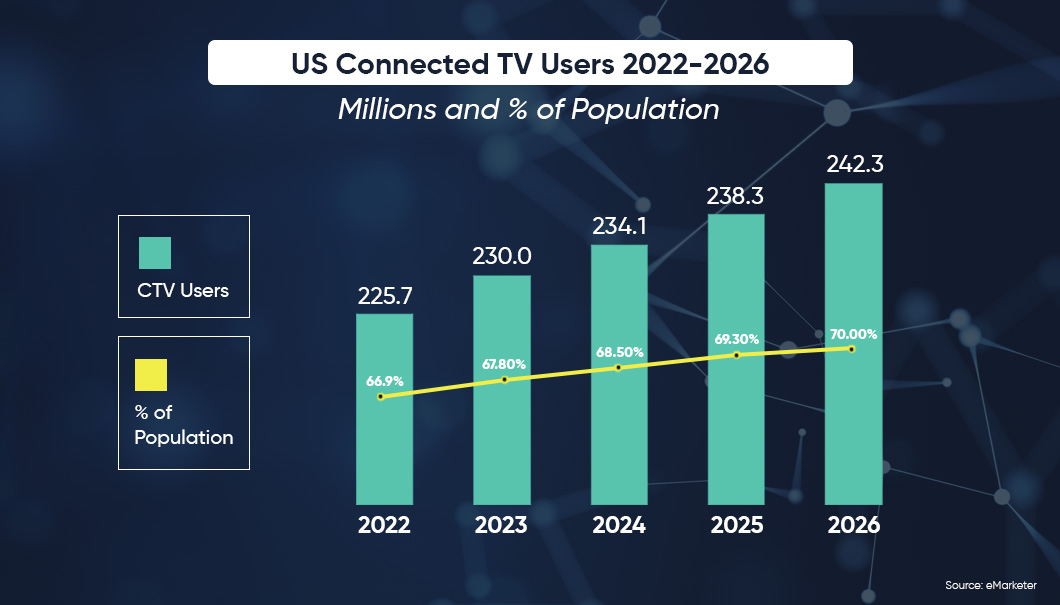
2. Precision Targeting Fuels Programmatic CTV Advertising Spend Surge
In 2023, it was anticipated that connected TV advertising spending in the U.S. would reach approximately $25.09 billion. It is evident that CTV ad expenditure is on track to expand to approximately $29.29 billion by 2024 and a substantial $36.86 billion by 2026. The primary driving force behind this remarkable surge can be attributed to the widespread adoption of streaming services by users.
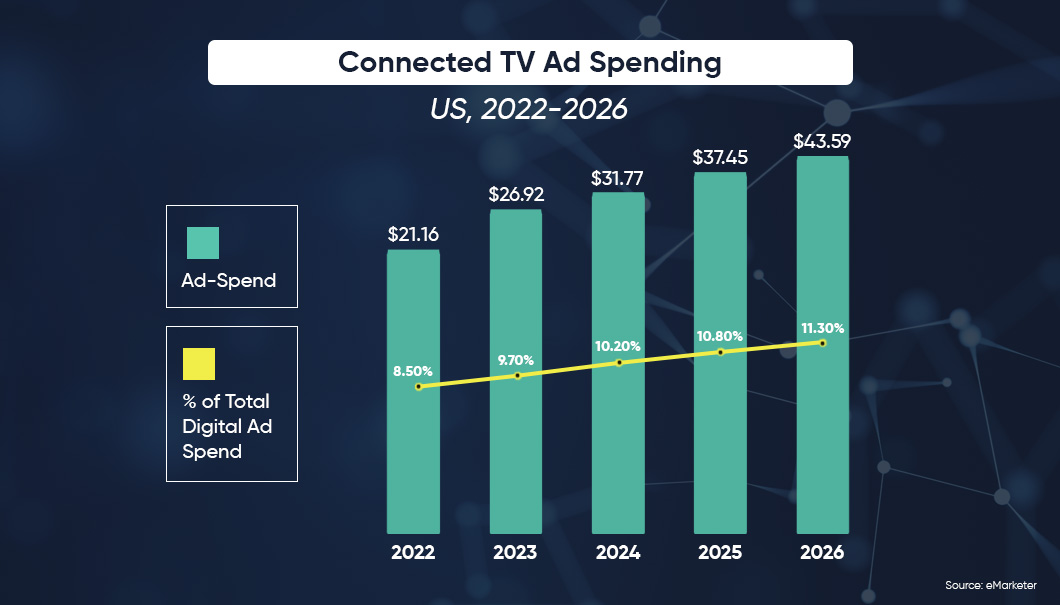
3. Enhanced Targeting on CTV Takes Center Stage
Connected TV (CTV) advertising offers advertisers a powerful tool for tailoring their ads to specific audience segments. This precision allows advertisers to deliver highly relevant ads to viewers, significantly boosting the likelihood of engagement and conversions. A survey done by the IAB found that 84 percent of advertisers think that CTV offers better targeting options in comparison to regular TV.
In 2024, brands can expect more sophisticated audience segmentation to deliver highly personalized and relevant ads.
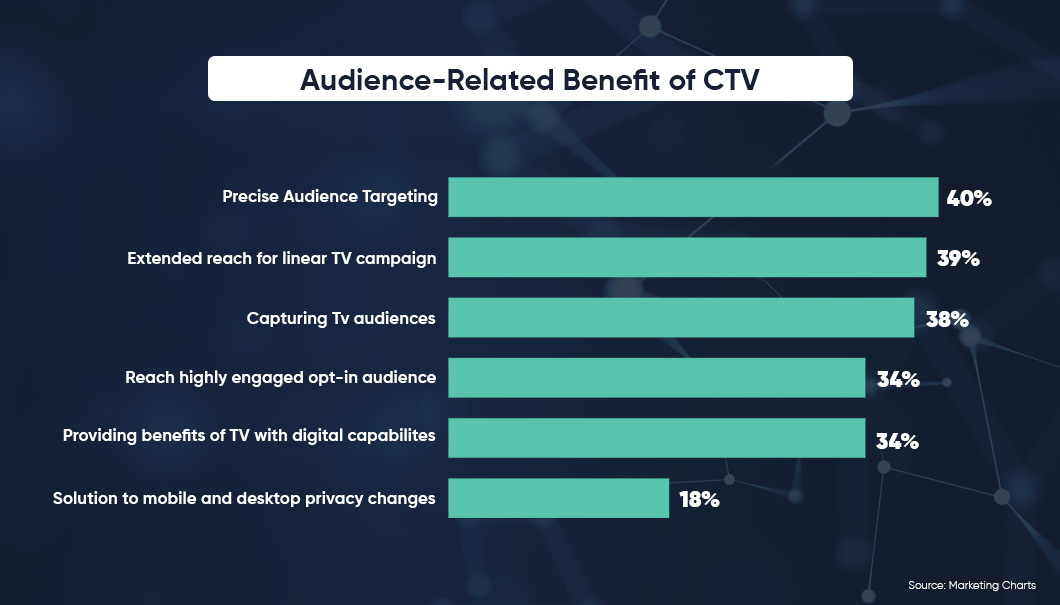
4. Elevated Engagement: Shoppable CTV Ads and Enhanced Interactivity
Shoppable ads are becoming increasingly popular as more and more consumers shop online, according to the latest CTV shopping trends. They offer a number of benefits for both consumers and businesses. For consumers, it shortens the consumer journey as they are able to make direct purchases for the products they are interested in. For businesses, shoppable ads can help to increase sales and brand awareness. They can also help businesses to learn more about consumer behavior.
Some formats that advertisers can leverage are:
- Product showcases: Highlight the relevant elements/features of the product that users can access with a tap.
- QR codes: Nothing beats the curiosity to know something and QR codes are the best curiosity generators. Advertisers can include QR codes or short links in ads, allowing viewers to scan or click for immediate access to the product page or a special promotion.
- Voice-activated purchases: Due to the growing use of voice-activated gadgets, advertisers can utilize voice commands in ads that allow viewers to make purchases or add products to their shopping lists using voice assistants, making shopping easier.
5. Integration of CTV with Cross-Channel Campaigns
CTV will increasingly become a central component of cross-channel advertising strategies. According to a study conducted by Digiday, respondents found one of the appealing aspects of CTV advertising to be its ability to integrate into an existing omnichannel strategy seamlessly.
The integration of CTV with cross-channel campaigns is a powerful way for advertisers to reach their target audiences more effectively and to measure the effectiveness of their campaigns across all channels.
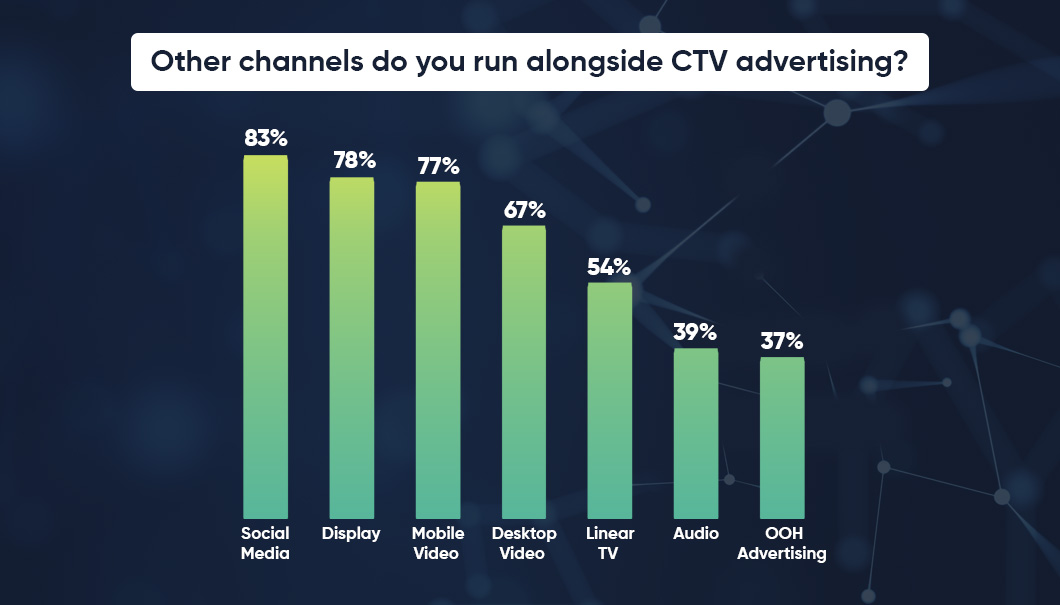
Here are some of the benefits of integrating CTV with cross-channel campaigns:
- Increased reach: This will allow advertisers to reach their target audiences on a variety of devices, including smart TVs, streaming sticks, and gaming consoles.
- Improved relevance: Advertisers will be able to target their ads based on demographics, interests, and behaviors, which can help to improve the relevance of their ads to viewers.
- Greater efficiency: CTV integration can help advertisers reach their target audiences more efficiently, which can lead to lower costs and higher ROI.
- Better measurement: CTV integration allows advertisers to measure the results of their campaigns more accurately, which can help them improve their performance over time.
Conclusion
In light of the gradual decline in linear TV advertising, CTV advertising trends research indicates that within the next four years, there will be a substantial decrease of $4.48 billion in US linear ad spending, while CTV is projected to witness a significant increase of $15.81 billion.
With advanced targeting capabilities and seamless integration with other platforms, predictions paint a promising and prosperous future for CTV ads. As such, advertisers would be wise to explore this platform’s full potential.
Unwrapping Advanced Contextual Advertising Solutions this Holiday Season
PUBLISH DATE: 14 July 2023
Thrive during the business’s busiest season and succeed with advanced contextual advertising solutions.
Why is this Holiday Season a “Prime” Opportunity for Advertisers?
As we approach the halfway mark of the year, it presents a prime opportunity to proactively plan for your upcoming 2023 holiday campaigns.
In 2022, holiday spending reached approximately $936.3 billion. Looking ahead to 2023, the trend continues; with retail spending expected to increase by 4.5% to $1.328 trillion during this time.
 Research shows that by advertising during this holiday season, ad impressions rise by 50%, click-through rates surge 100%, direct traffic increases by 150%, average order value jumps 30%, and conversation rates soar by 60%.
Research shows that by advertising during this holiday season, ad impressions rise by 50%, click-through rates surge 100%, direct traffic increases by 150%, average order value jumps 30%, and conversation rates soar by 60%.
Now you won’t underestimate the power of holiday season advertising!
Moreover, in the U.S., sales increase dramatically as early as October. As per data, almost 40% of consumers check off items from their holiday shopping lists by the end of October.
If you have not started your holiday advertising yet, the time is now! Leverage this opportunity and position your brand as the top choice in your target audience’s mind. Here are the must-know holiday advertising ideas to kickstart your holiday advertising.
Read More: Ace Back to School Advertising with the Power of Context
Success in Every Season: 4 Simple Holiday Advertising Ideas to Get Started
1. Discover Relevant Audiences in the Cookieless World

Reaching target audiences with ethical personalization and relevant ads has become increasingly difficult due to the demise of third-party cookies and limited first-party data.
Additionally, stereotypical assumptions made by advertisers during the holiday season have led to a decline in click-through rates and overall return on investment (ROI).
A clothing store ad shows women shopping for holiday outfits, reinforcing the stereotype that all women enjoy dressing up. It overlooks the fact that women have diverse interests like outdoor activities, reading, and hiking, beyond just shopping.
To overcome stereotypes, advertisers should create inclusive and personalized messages that respect individual preferences.
By understanding their customers’ unique characteristics, they can deliver engaging ads that appeal to a diverse audience.
Advanced contextual targeting solutions like Mirrors Generative AI have proved to be a co-pilot to human intelligence by eliminating traditional audience-based stereotypes and tapping into unexplored audiences with multiple alternative interests.
This has empowered advertisers to expand their reach without sacrificing engagement, while also enabling them to tap into previously untapped or overlooked audiences.
2. Invest in Omnichannel Advertising

A multi-channel strategy enables you to reach users across different platforms and channels. This is an essential strategy in today’s digital landscape because it can enable you to achieve greater reach by capturing users wherever they are online.
Silverpush’s omnichannel advertising capabilities help advertisers reach their targeted audiences on multiple platforms including YouTube, CTV, Meta, and OpenWeb.
To let advertisers take full control of their advertising campaigns, Silverpush has recently launched Mirrors Self-Serve Chrome Extension to auto-optimize their campaigns with privacy-friendly tags and gain access to real-time data sets.
3. High-Impact CTV ads

The dramatic rise in CTV advertising has brought a major change in advertising budgets and strategies. As audiences flock to streaming platforms, advertisers are following suit, viewing CTV as an ideal space to reach an engaged, targetable audience. Recognizing the potential of CTV as an ideal space for advertisers, Silverpush has integrated with IRIS TV to leverage its rich video inventory and enhance the effectiveness of CTV ad campaigns.
4. Engage Audiences With Interactive Video Advertising

It’s time for advertisers to display ads that allow users to interact with them rather than simply watch them. This can play a very important role in increasing ad engagement and people are more likely to remember your ad. This can lead to better brand awareness and recall, as well as increased click-through rates (CTRs). For this reason, Silverpush has launched cutting-edge dynamic video optimization technology to transform traditional ads into highly advanced interactive ads.
From Festivities to Profitability: Achieve Holiday Marketing Success with Mirrors
This holiday season presents a prime opportunity for advertisers to iron out a powerful advertising strategy. Don’t miss out on this chance to elevate your holiday campaigns with Mirrors. Contact us now to learn more about how Silverpush can transform your holiday advertising strategy and drive success during this festive season.
How Does Silverpush Ensure Brand Safety in CTV Advertising?
PUBLISH DATE: 03 July 2023
Connected TV (CTV) is an exceptionally fast-growing advertising channel that continues to gain momentum with no signs of slowing down.
According to data, 87% of US TV households have at least one Internet-connected TV device.
As the number of CTV households continues to rise, advertisers are swarming toward this dynamic advertising platform to maximize the impact of their ad campaigns.
However, it is essential for advertisers to maintain brand safety in CTV advertising by ensuring their ads are not placed alongside inappropriate or offensive content. Failing to do so could severely damage the advertiser’s reputation and alienate its customer base.
Brand Safety Issues on Connected TV Advertising

In 2022, the global brand safety loss was around $3.1 billion and is projected to reach $3.4 billion in 2023.
An eye-opening study conducted by the IAB revealed that a significant 72% of advertisers express concerns about brand safety specifically in the context of CTV advertising.
Adding weight to these concerns, the same study found that 58% of advertisers have encountered instances where their ads were displayed alongside non-brand-safe content on CTV platforms.
These alarming statistics are further supported by real-life examples that highlight the pressing need for brand safety measures in CTV advertising. These instances serve as concrete evidence, illustrating the potential risks and consequences of ads being associated with objectionable or offensive content.
What is the Example of Brand Safety in CTV Advertising?
In 2021, the luxury goods brand faced a brand safety issue when its ads were shown alongside violent content on a CTV platform. The ads were placed next to a platform known for its violent content.
This led to complaints from the product’s customers, who were concerned about their brand being associated with violence.
The brand quickly apologized for the incident and took steps to prevent it from happening again.
The company worked with the CTV platform to ensure that its ads were placed alongside brand-safe content in the future. It also updated its brand safety policies to include CTV advertising.
This incident shows that even the most experienced brands can face brand safety issues on CTV. It is important for brands to be aware of the risks and take steps to mitigate them.
Mirrors TV: Placing Ads in Safe and Suitable Environments for Effective Engagement
Silverpush Mirrors TV is an advanced contextual solution for CTV advertising; leading the way in offering the world’s first in-video visual and audio recognition technology, enabling frame-by-frame in-video analysis for CTV.
With its state-of-the-art technology, Mirrors TV empowers advertisers to seamlessly align their ads with the relevant content viewers are engaged with, ensuring a harmonious and immersive viewing experience.
Its cutting-edge AI-powered technology revolutionizes targeting and enables personalized, contextually relevant ads in a secure and suitable environment. Also, the platform leverages enriched 300+ verified IAB category segments, without relying on metadata.
To ensure brand safety in CTV, the platform adheres to privacy regulations such as HIPAA, GDPR, and CCPA. Thus, ensuring refined and accurate targeting to meet suitability needs, allowing brands to easily avoid unsafe, unknown, or unverified channels through custom exclusion features.
Also Read: How Does Silverpush Ensure Brand Safety and Suitability on YouTube?
How Does Mirrors TV Works?
We utilize cutting-edge AI models to process CTV content, extracting relevant context from the video feed with our advanced key context identification algorithms. Our technology enables us to accurately analyze and categorize video content, providing valuable insights for targeted advertising and content recommendations.

Last Words
Mirrors TV recognizes the significant concern of advertisers regarding brand safety in CTV advertising, and therefore, it plays a crucial role in ensuring the placement of ads in both relevant and secure content. By forging partnerships with trusted and reliable associates, Mirrors TV effectively avoids unsafe, unknown, or unverified channels. Furthermore, Mirrors TV offers customizable exclusion features, enabling advertisers to maintain greater control and ensure their ads appear only in safe and verified environments. With these measures in place, Mirrors TV provides advertisers with the peace of mind they seek, while delivering impactful advertising campaigns.
Challenges and Opportunities of CTV Advertising
PUBLISH DATE: 04 April 2023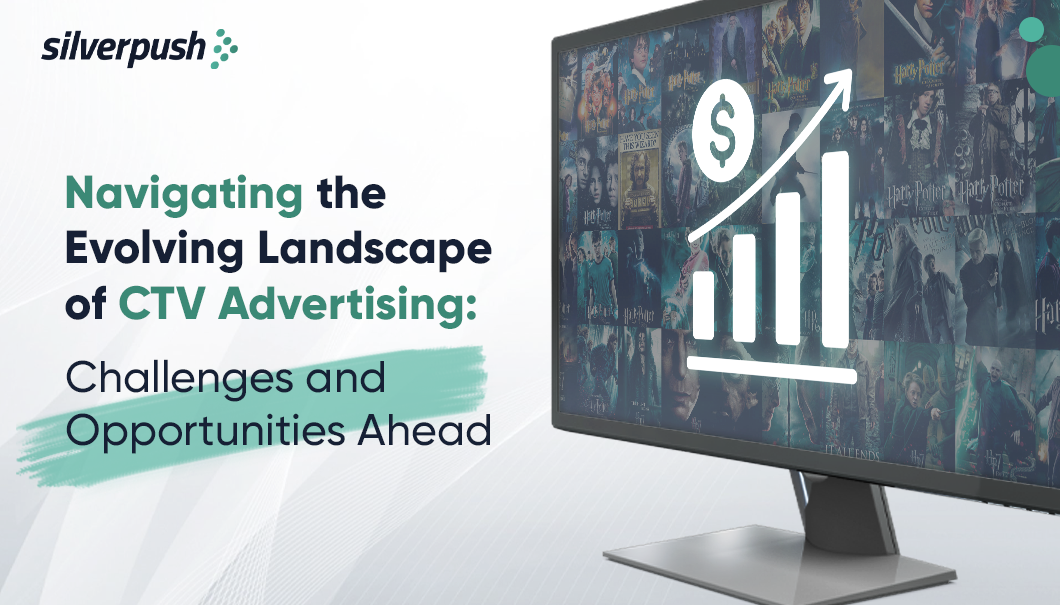
CTV advertising is growing in popularity and so should your brand. If you’re not using this platform already, you’re missing out on a major opportunity. Read the blog to know why.
In 2022, CTV ad spending in the United States was expected to amount to roughly 19 billion U.S. dollars, marking an increase of 33 percent from the previous year.
This growth is only expected to continue in the coming years, as more and more consumers shift from traditional TV viewing to streaming on connected devices.
According to a report by eMarketer, CTV ad spending in the US is expected to reach $27.8 billion in 2024, representing a compound annual growth rate (CAGR) of 20.8% from 2020 to 2024.
The rise of CTV advertising presents a significant opportunity for advertisers to reach consumers with targeted and engaging ads more measurably and cost-effectively than traditional TV advertising.
Additionally, CTV advertising offers greater flexibility and control, allowing advertisers to adjust their campaigns in real-time based on performance data.
However, as Connected TV advertising continues to grow in popularity, it will be important for advertisers to address the challenges and opportunities that exist in this space.
Challenges of CTV Advertising
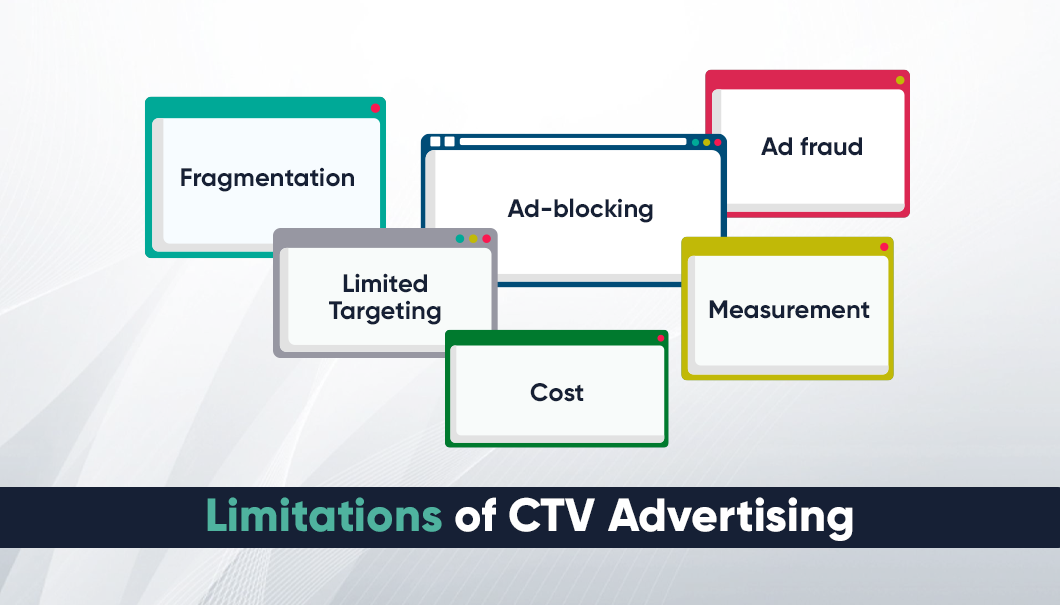
CTV (Connected TV) advertising has been growing rapidly in recent years, but it still faces some challenges. Here are some of the challenges of CTV advertising:
1. Fragmentation: There are many different platforms and devices that consumers use to access CTV content, which can make it challenging for advertisers to reach their target audience efficiently.
2. Ad-blocking: Just like with traditional digital advertising, many viewers of CTV content use ad-blocking software, which means that advertisers may not be able to reach their intended audience.
3. Limited targeting: While CTV advertising offers some targeting capabilities, such as targeting based on location or device type, it is still more limited than other forms of digital advertising.
4. Measurement: Measuring the effectiveness of CTV advertising can be difficult, as there is no standard method for tracking viewership across different platforms and devices.
5. Ad fraud: Like any form of digital advertising, ad fraud can be a problem in CTV advertising. This can include things like fake impressions or click fraud.
6. Cost: CTV advertising can be more expensive than other forms of digital advertising, particularly if advertisers want to reach a wide audience across multiple platforms and devices.
What are the Benefits of CTV Advertising?
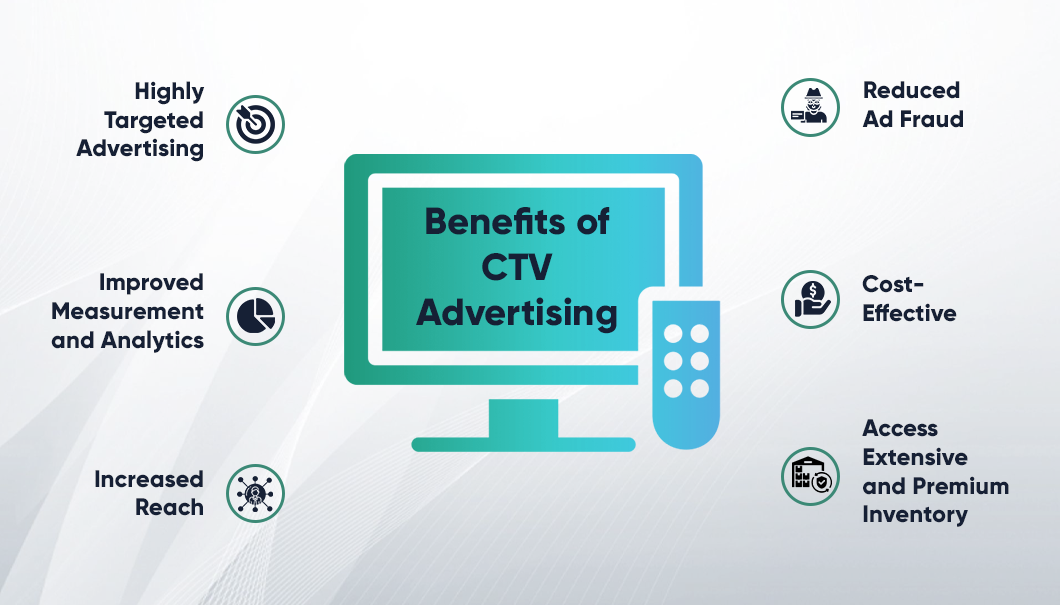
CTV advertising presents several opportunities for advertisers, including:
1. Highly targeted advertising: CTV advertising allows advertisers to target their ads based on specific audience demographics, interests, and behaviors. This helps advertisers deliver more relevant ads to viewers, increasing the chances of engagement and conversion.
2. Improved measurement and analytics: CTV advertising provides advertisers with access to detailed metrics such as ad completion rates, viewability, and engagement rates. This enables advertisers to track the effectiveness of their campaigns and make data-driven decisions to improve future campaigns.
3. Increased reach: With the growing popularity of streaming services, CTV advertising offers a massive and growing audience that can be reached by advertisers. According to eMarketer, there were 195.1 million CTV users in the US in 2021, a number expected to grow to 204.2 million in 2022.
4. Reduced ad fraud: CTV advertising provides better security and transparency than traditional TV advertising, as it is easier to detect and prevent ad fraud.
5. Cost-effective: CTV advertising can be more cost-effective than traditional TV advertising, as it allows advertisers to target specific audiences more precisely, which can reduce wasted ad spend.
6. Access Extensive and Premium Inventory: Advertisers can tap into the extensive CTV advertising inventory offered by over-the-top (OTT) services through open exchanges or private marketplace deals. BasisTV+ provides access to 93% of US smart TVs.
7. Create a Personalized and Omnichannel Experience for Consumers: To create a personalized ad experience, targeting strategies can be used along with an omnichannel approach. When buying a product seen in an ad, it may have been encountered through various channels like Instagram, Google search, or a video ad during a Hulu binge-watch.
Last Words
As CTV advertising continues to grow in popularity, it will be important for advertisers to stay up-to-date with the latest developments in technology and tactics to make the most of this advertising channel. By using targeting strategies, an omnichannel approach, and taking advantage of the benefits of CTV advertising. Advertisers can create a personalized and intentional ad experience for their target audience with the help of Silverpush’s AI-powered hyper contextual technologies, Mirrors built for CTV. Mirrors ensure all your ads are displayed on premium content and brand-safe CTV video inventory after they are enhanced contextually. To know more about how you can make the most out of CTV with Mirrors, fill out the form on your right and a member of our team will soon contact you.
Super Bowl Advertising: A Month-Long, Multi-Screen Event for Brands
PUBLISH DATE: 30 January 2023
For Americans, there are two events that they hyped for a whole year – Football season, and waiting for football season. Football remains highly popular among Americans, with searches for “NFL Draft” and viewership numbers showing an unwavering interest in the sport. According to Google Search data, football is more popular than any other sports league in the US. Despite the challenges faced by the sport this year, the NFL’s popularity continues to rise, with Nielsen data showing a steady increase in viewership over the past decade, outperforming the top 10 network shows.
The upcoming Super Bowl in February is expected to attract a large audience, making it an attractive opportunity for brands to invest in marketing. Historically, brands have focused on airing expensive commercials during the game, but as consumer behaviors change, the window of opportunity for brands has expanded. As a result, more brands are taking advantage of this opportunity to reach a larger audience.
Super Bowl Ad Cost History
The Academy Awards show is the only event that comes close to having the largest TV audience in the US, but the NFL’s Super Bowl remains the largest TV spectacle, both in sports and the country. Despite some decline in certain areas, the Super Bowl is still considered the ultimate advertising platform by brands and attracts many companies to showcase their products and services.
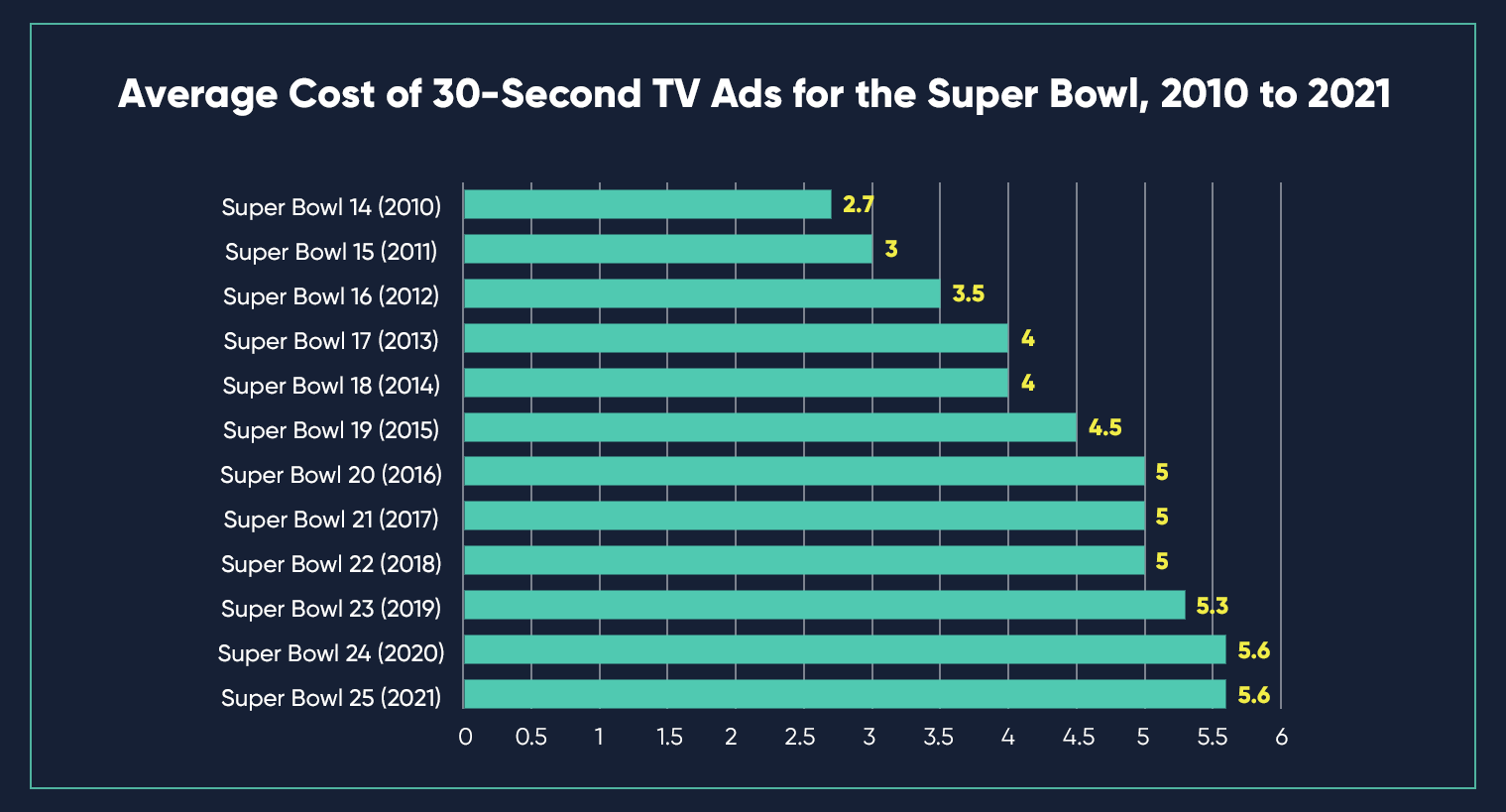
Reaching the Right Audience has Never Been Easier
As the Big Game approaches and signals the end of the NFL season, advertisers are eager to take advantage of one of the year’s largest TV events, attracting over 100 million viewers annually. Despite a decline in overall viewership last year, the game broke the record with 1 billion total streaming minutes, signaling a shift in the way people watch the event. The entire week presents a major opportunity for advertisers to reach a vast audience across all devices, balancing the reach of linear TV with the convenience of streaming.
Focus on the Task Ahead
Advertisers should take advantage of the fact that viewers don’t just watch the game, but spend the whole weekend consuming related content and updates. This includes the pre-game show, city festivities in Los Angeles, team interviews during media week, and more, providing multiple touchpoints for advertisers. With the extended amount of time, advertisers can reach their target market through various streaming channels, including phones and other devices, expanding beyond just TV viewership.
Achieve More with Less
Advertising during the Big Game is costly, with NBC reported to charge up to $6.5 million for a 30-second spot. However, businesses can still reach their target audience at a lower cost through CTV advertising. CTV ads can be targeted based on online behavior, allowing them to reach the intended audience even if they’re not watching the game.
Targeting Relevant Audiences with Geo-Fencing During the Big Game
Advertising during the Big Game offers a unique opportunity to target relevant audiences through geo-fencing. Advertisers can reach users who have taken action to be at locations such as the stadium, team hotels, host city, and other events related to the game. These audiences are highly engaged, and advertisers can retarget them during and after the game, even across all devices in their household. With granular reporting and attribution, brands can track online and offline conversions and see the impact of each individual geofence from the Big Game weekend.
CTV campaigns offer a chance for advertisers to reach relevant audiences with high-impact ad campaigns. During the big week, many advertisers struggle to stand out, but those using a programmatic platform are better equipped for success. The number of people streaming the game is rising, and fans will be using multiple devices, providing advertisers with opportunities to reach their desired audiences. Real-time reporting also provides insights into campaign performance, allowing advertisers to quickly adjust and allocate budgets to higher-performing channels and markets. Every advertiser has a chance to participate in TV’s biggest event.
Ignoring CTV Advertising in 2023 is Not an Option: Here are the Top 5 Reasons Why
PUBLISH DATE: 10 January 2023
Learn the top 5 reasons why connected TV advertising should be a part of your omnichannel marketing mix in 2023.
Introduction
Over one-third of American households now rely on streaming for their television entertainment. How can marketers stay caught up when the majority of the audience is cutting cords?
According to an IAB survey, buyers are shifting their ad spending away from broadcast (53%) and cable TV (52%), and toward CTV advertising.
Dive deep into this blog to learn why connected TV advertising has become one of the fastest-growing video advertising platforms in 2023.
Benefits of Connected TV Advertising
1. Meet your Audience Where they’re

80% of U.S. households have at least one connected TV, including a smart TV, video game system, or streaming box. To boost conversions, brands need to reach consumers where they are spending their maximum time, i.e. connected devices. Have a look at the statistics below:
1. Streaming has increased by 266% globally in the last three years.
2. According to Conviva data, more than 500 million unique users watch 200 billion streams every year.
2. Advanced Targeting at a Lower Cost
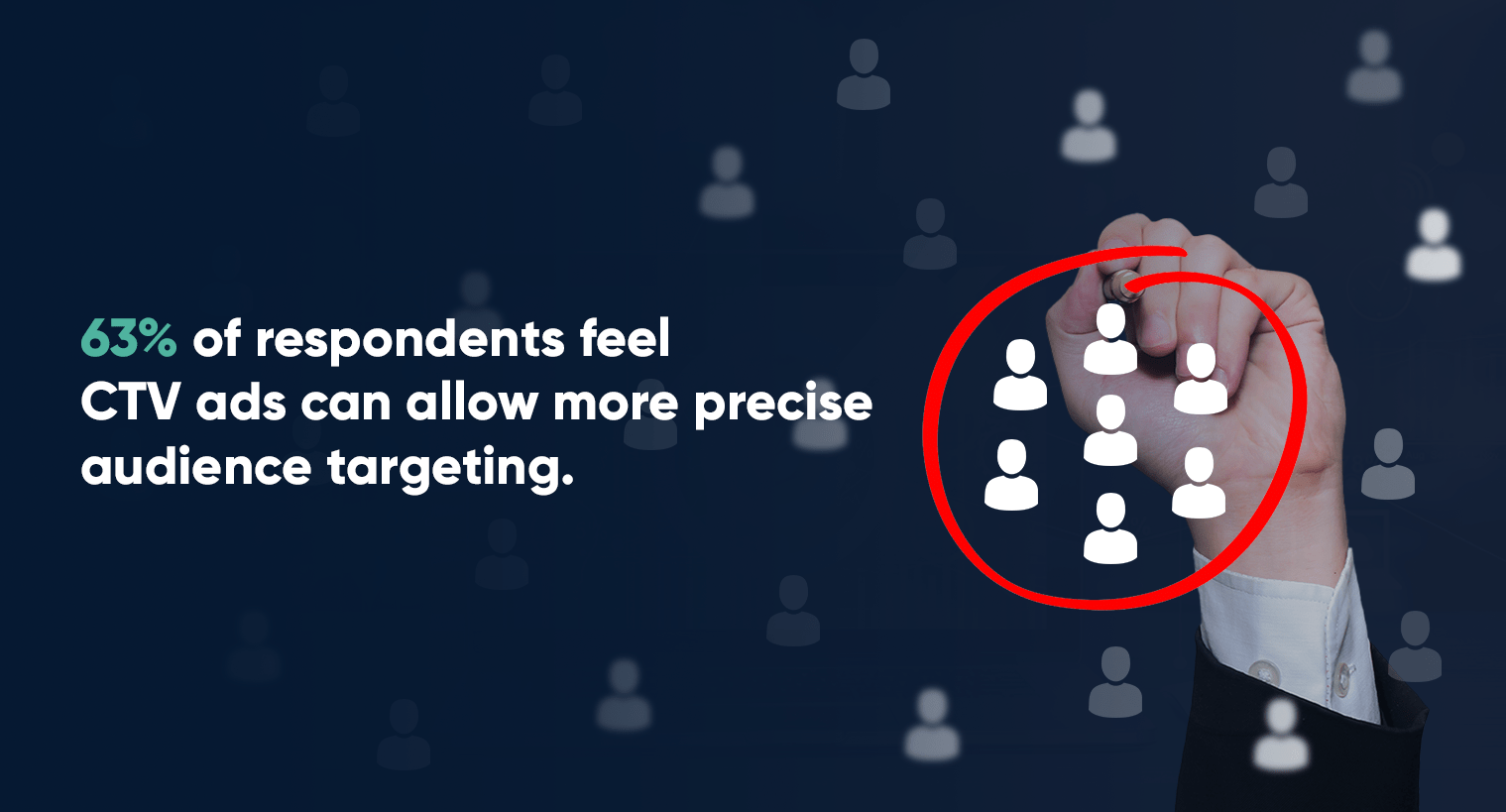
Brands can use connected TV advertising to select a target audience from an existing list. This helps you to meet your goal with far less money wasted and reach the target audience with engaging ads.
3. Consumers are More Receptive to CTV Ads

86% of customers are willing to view ads that are interesting or relevant to them, whereas just 40% are expected to reject CTV if there are too many ads. It’s no secret that customers are more tolerant of connected TV advertising since they are viewing content they like far less expensive than scrolling through stations on cable television.
4. Progress can be Tracked Easily

Since connected TV advertising works programmatically, it offers brands the opportunity to track their success through different methods including Video Completion Rate (VCR) and Automatic Content Recognition (ACR).
5. Improved Completion Rates

In North America, 95% of video ad impressions viewed on connected TV devices were completed in 2020, while the average completion rate was 80%. This is likely because brands include more non-skippable ads within the streaming content, which ensures that their message was seen by the audience.
Gear Up for CTV’s Biggest Evolution
In today’s digital age, brands and advertisers need to reach consumers where they are spending their time. Silverpush’s AI-powered connected TV (CTV) advertising provides brands a unique opportunity to connect with the global audience by delivering ads that are contextually relevant, engaging, and effective. To know more click here.
The Future of CTV: Drive Audience Engagement with New Ad Formats
PUBLISH DATE: 04 January 2023
2021 was a record year for CTV.
At least one CTV device could be found in over 80% of American homes, and the CTV budget is expected to double by 2026.
However, the key to unlocking those ad dollars lies in connection to unite audience-based buying with the sort of high-quality, engaging content for which linear TV is traditionally known.
The ad industry in the U.S. and beyond has enjoyed a significant increase in revenue since CTV was exposed in popularity, especially during the pandemic. A trend that is very promising in the future and is set to continue. It’s time to consider new forms of audience engagement.
Why the CTV-Based Content Drives Higher Engagement?
At least 60% of people have defined their definition of TV to include streaming services such as Youtube, Netflix, and others, meaning that traditional terrestrial TV has gradually shifted to a secondary role. Streaming services have become the primary choice amongst people for video content. It provides the public to pay for only what they want but also opens the door of opportunity for advertisers via increased engagement.
Viewers experience greater engagement when watching CTV-based content as compared to traditional TV. There are three reasons for this. Firstly, there is a far greater scope in CTV for personalization, which makes the content more interesting for the average consumer to consume. Secondly, there is a huge variety of channels and content one can find on CTV app stores as well as through in-channel ads that are targeted precisely to a relevant audience. Lastly, there’s more and more room for interaction, that is very much similar to mobile ad stories.
Evolution of CTV Ad Formats
It’s interesting to note the amount of options ad creators have at their disposal and new formats are being created constantly. One such example of ad format is a dynamic overlay, in which existing video content is placed over another video and then personalized on the basis of the data targeted to their specific demographics and interests.
Next in line is voice-integrated video, where consumers can direct ads by their voices to follow prompts on their screens, and sequential ads that run over multiple slots.
One of the most promising ad formats however is an Actionable video that connects viewers to brands through external links, opening the door for potential click-to-buy opportunities.
People are multitaskers and multi-screeners, which means CTV is usually about dual screening. Viewers are subjected to both CTV/OTT and mobile sway, raising the chances of user interaction. CTV’s future can hold increased user choice in ad format and inclusion of more QR codes for purchasing the product directly, keeping multiple device users in mind.
Innovative ad formats together with a contextual approach can boost engagement to unexpected figures.
Bright Future Ahead
Interactive ads work a lot better as they retain user attention for up to 85 seconds longer than conventional ad content, a huge difference to witness. On top of this, they also enjoy 3.5% higher engagement rates as well. All in all, interactivity combined with video content is an effective way for marketers to attain valued customers.








